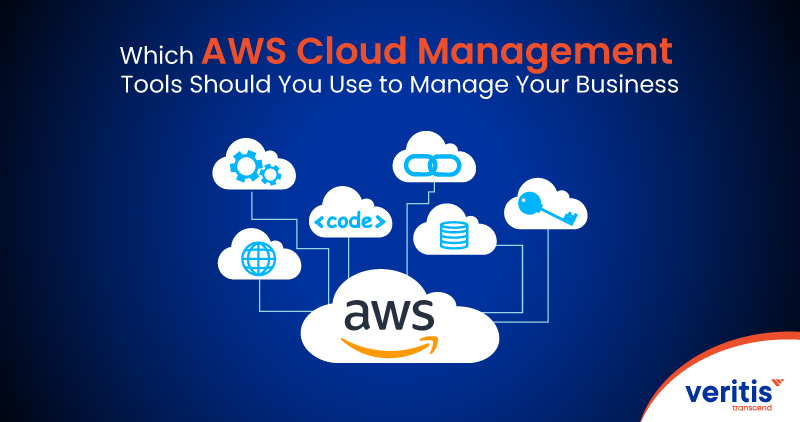
Amazon Web Services (AWS) provides secure, reliable, and scalable platforms that enable businesses to create and implement cloud based workloads, as more firms undergo digital transformation. For their business purposes, these enterprises require multiple cloud management technologies. Managing an AWS cloud may become incredibly complex without the right tools.
AWS offers a variety of AWS cloud management tools and collaborates with certified competency partners who specialize in cloud solutions to help organizations operate their cloud infrastructure efficiently. These tools are essential for managing, monitoring, and optimizing Amazon based infrastructure, allowing businesses to maintain seamless scalability, security, and cost effectiveness.
Cloud computing with Amazon Web Services is accessible to businesses of all sizes. AWS offers inexpensive cloud storage, virtually limitless processing power, and safe remote computing services. Unfortunately, Amazon continues to confuse many users.
AWS billing might be difficult for businesses to comprehend. Matching cloud spending to actual operational expenses is nearly impossible for cost allocation purposes. The AWS application server also limits the amount of computational power you can consume based on your location. Activating auto scaling may make it difficult for many users to control costs.
Utilize powerful management tools to efficiently manage your AWS cloud without incurring costly errors. The best place to start right now is with AWS native cloud management tools. In addition, consider more sophisticated AWS cloud management solutions if you want better control over the public cloud.
Although this provider of cloud environments aimed to offer organizations highly personalized and efficient solutions, losing in the management tools for AWS is very simple. Each can perfectly meet most technology business management requirements and development objectives. To help you make an informed decision that adds value, we have created a detailed guide to Amazon administration tools in this blog post.
What are Cloud Management Tools?

Cloud management tools enable enterprises to manage their multi cloud resources and services (including public clouds and on-premises). These tools include configuration, operation, control, management, and optimization. The administration tools for Amazon Web Services are a perfect illustration of these.
Each vendor has a different feature set for their cloud management platform (CMP). While some focus on more generalized industries or vertical markets, others offer a more specialized range of tools. Furthermore, some companies provide cloud management platforms as on-premises applications, while others provide software as a service (SaaS). Cloud management generally relates to administering control over public, private, hybrid, and multiple cloud deployments.
Integrating cloud service management that can deploy and orchestrate cloud computing services across a multi vendor landscape is essential for businesses. The management of cloud based server solutions includes everything from planning and directing business management software resources to ensuring strict compliance and the security of any data stored there.
You can complete each activity using a specific Amazon platform that is well suited to the use case and objective. You may anticipate the following advantages depending on the kinds of Amazon data services you use for your company:
- Improved security
- Control and flexibility of resource utilization
- Integrated seamlessly
- Accessibility
- Backup and Recovery
- Staying Updated
- IT cost reduction
- Flexibility and Scaling
What Are AWS Cloud Management Tools and Why Do They Matter?
AWS Cloud Management Tools are specialized platforms and services designed to help enterprises manage, monitor, and optimize AWS infrastructure. As organizations expand into multi cloud environments and adopt hybrid strategies, the complexity of managing workloads, resources, and costs increases. AWS management solutions provide governance, automation, observability, and cost optimization, empowering businesses to stay secure, compliant, and cost efficient while scaling.
Continue with our AWS management services to determine which AWS administration options suit your company. Below, we have described and categorized Amazon’s online consulting services management solutions according to use case, functionality, and commercial potential.
Useful link: Accelerate Business Growth with AWS Cloud Migration
AWS Cloud Management Tools
1) Monitoring and Logging Tools
These Amazon management tools enable you to monitor and analyze your logs or log files, which store data about system operations, and display the results in a user friendly dashboard.
They gather and examine logs from numerous Amazon EC sources, providing comprehensive details on your AWS environments and apps. From the perspective of commercial value, these solutions can ensure more adaptability, improved performance, increased security, and staying in existence.
Amazon CloudWatch

Amazon Cloud Watch’s primary responsibilities are data gathering and analysis. It gathers information on changes in your app’s performance and resource usage, classifies this information, and displays it in a single dashboard. AWS management tool evaluations state that this solution is clever, simple, and efficient.
Benefits
- Operational analysis and control
- The possibility of gathering data from several sources
- Convenience: You can access several metrics from a single platform
- Anomaly control and detection in real time
- Opportunities for customization and cost savings, such as the ability to halt your instances at a specific moment to reduce costs.
2) Cloud Resources Provisioning Tools
Resource management is an essential feature of cloud management solutions. Thanks to this capability, IT can manage each resource. Cloud resource allocation, procurement, and management are specific tasks that cloud provisioning technologies manage.
Since the vendor’s cloud offers more significant opportunities for scalability than deploying your on-premise infrastructure, these are the fundamental AWS cloud management tools. In addition, these are the only solutions that support the idea of using the cloud provided by the vendor rather than deploying your on-premise infrastructure.
AWS CloudFormation

As its name suggests, AWS CloudFormation is a platform that enables the collection, modeling, and management of both internal and external cloud resources from a single location by modifying both the infrastructure and the code. This solution includes a pre made template that details the dependencies and suggests strategies to handle them better.
AWS CloudFormation Advantages:
- Automatic suggestions
- Reviews and updates
- Automatic Patching
- It’s one of the best Amazon multi cloud management tools for managing your cloud infrastructure.
- Integration with other AWS service management technologies
Useful link: AWS vs Azure vs GCP: Cloud Cost Comparison
3) Managed Services and Configuration Tools
As organizations migrate to the cloud and configure AWS consulting services, individuals requiring additional technical expertise can find comprehensive solutions in AWS managed service providers and configuration tools.
This is a list of pre made services the Amazon platform can offer you, including a wide range of essentials. Although the cost of an AWS managed service provider can scale, the cost is predictable. Along with automatic backup and disaster recovery services, they also offer cybersecurity and compliance help.
AWS Systems Manager

An AWS System Manager is a solution that uses a single interface to assist in managing Amazon EC2 and Amazon RDS instances. It is also appropriate for automating repetitive processes, maintaining compliance, and managing hybrid settings.
Benefits
- Your resources and apps can be managed more easily.
- Reducing the time and expense needed to identify and resolve issues.
- Interfaces with Amazon Cloud Watch, for instance, work seamlessly.
4) Operations Management Tools
While the first set of AWS management services enables strategic distribution and collection of cloud resources, operations management tools powered by Amazon provide solutions to configure and adapt your cloud based servers to meet your business management software requirements.
With these AWS application servers, you can protect your company from data loss, increase productivity by aligning your operations with the activities and objectives at hand, and deliver greater value to your clients with the consistency and responsiveness they need.
AWS Service Catalog

The tool used by AWS developers to create and maintain IT catalogs, including servers, databases, virtual machines, and environments, is called the Amazon Service Catalog. By establishing the access and skills to manage software versions and IT services, you can centrally manage your apps and metadata.
Benefits
- Your own IT services catalog with adjustable access controls for your consumers and staff
- Throughout their lifecycle, IT services are managed centrally and transparently.
- Integrating seamlessly with AWS’s multi cloud management tools, governing framework, and provisioning solutions
Useful link: Top 15 AWS Machine Learning Tools in the Cloud
5) Reporting and Cost Optimization Tools
As its name implies, this set of tools’ primary purpose is to find and identify weak spots, report on your resource usage in real time, and cut expenses related to unused processing power. This is a valuable collection of options for people using the Pay as You Go AWS marketplace pricing model because, despite its adaptability, it could be a costly option if specific resources are squandered.
AWS Cost Explorer

Amazon Cost Explorer is a powerful cost management tool since it gives you fast access to spending information through a visual dashboard.
Benefits
- It is free for you to use (however, it will be paid to support the API)
- The most recent 12 months of data are available for viewing.
- Overviews of spending trends are available.
- Also, you may forecast your expenses for a year.
Third Party AWS Cloud Management Tools
While AWS native tools cover most enterprise needs, third party platforms enhance multi cloud visibility and advanced analytics:
- CloudHealth by VMware: Multi cloud cost optimization and governance
- Datadog: Monitoring, observability, and real time alerts
- New Relic: Application performance monitoring (APM) with AI insights
- Spot.io by NetApp: Automated cost optimization for AWS workloads
- Terraform by HashiCorp: Infrastructure as Code for AWS and hybrid deployments
Security and Compliance with AWS Management Tools
Enterprises in healthcare, finance, and government must enforce strict compliance and security controls. Tools such as AWS Security Hub, IAM, GuardDuty, and Config provide:
- Continuous threat detection and compliance auditing
- Enforcement of zero trust security frameworks
- Automated governance policies across workloads
- Audit ready reports for HIPAA, GDPR, SOC 2
How AWS Cloud Management Tools Support DevOps and Automation
Enterprises embracing DevOps rely on AWS for automation and agility. Tools like CloudFormation, OpsWorks, and Systems Manager integrate with CI/CD pipelines, enabling:
- Infrastructure as Code for repeatable deployments
- Automated patching and scaling
- Consistency across hybrid and multi cloud environments
- Faster time to market through agile delivery
Future of AWS Cloud Management: Trends for 2025
AI and predictive automation will shape the future of AWS management. Emerging cloud computing trends include:
- AI CloudOps for proactive remediation and anomaly detection
- Unified observability platforms integrating logs, metrics, and traces
- Serverless monitoring tools for AWS Lambda and containers
- Enterprise FinOps maturity models for advanced financial governance
- Hybrid cloud governance across AWS, Azure, and GCP
Case Study: Enhancing Cloud Management for a Pharmaceutical Client
Veritis, understanding the unique needs of the pharmaceutical industry, engaged with a leading pharmaceutical company to deliver end to end cloud computing services tailored to the industry’s strict compliance and performance standards. The client, in need of robust visibility, control, and automation across their AWS environment, turned to Veritis for a solution. Veritis deployed key AWS Cloud Management Tools to streamline operations, encompassing monitoring, cost tracking, security, and resource optimization. These tools were crucial in helping the client maintain regulatory compliance, scale efficiently, and ensure high system availability.
This case illustrates the tangible benefits of utilizing AWS Cloud Management Tools in complex, compliance driven industries such as pharmaceuticals.
Read the complete case study: Cloud Computing Services for Pharmaceutical Industry.
Conclusion
Each of the administration tools in Amazon Web Services that we have explored is essential for a successful cloud setup and operation. However, careful technology business management analysis can help you identify a key objective to achieve directly, thereby increasing the effectiveness of your company’s use of Amazon AWS.
Make your ultimate decision after communicating with Veritis experts. Then, you can contact the Stevie Award winner, Veritis, and discuss your project. We would be happy to assist you in getting started with Amazon services!